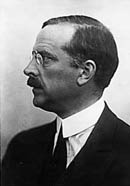Biography:
Clemens Peter Freiherr von Pirquet was the progeny of a Lower Austrian
noble family, the term Freiherr corresponding to English baron. His
brother was Guido von Pirquet (1880–1966), a specialist in ballistics
and thermodynamics and one of the early pioneers of space exploration.
He initially planned to study for the clergy and attended a Jesuit
boarding school in Kalksburg before he commenced the study of theology
at the University of Innsbruck. However, he soon changed to the study
of philosophy at the University of Löwen, but then changed his
mind again and studied medicine at the university of Graz.
He qualified in medicine i Graz in 1900 and became doctor of medicine
that year. As a newly fledged physician he became an assistant under
Theodor Escherich (1857-1911) at the Children's clinic in Vienna.
After habilitating for paediatrics in 1908, he had achieved such fame
that he was invited to America to become professor of paediatrics
at the John Hopkins University in Baltimore, a tenure he held
for two years. In 1910 he returned to Europe to take over the chair
of paediatrics at Breslau. The following year, 1911, he was
appointed Escherich's successor in Vienna, holding that tenure
until his tragic death on February 28, 1929.Von Pirquet primarily
devoted himself to bacteriology and immunology. In 1906 he noticed
that patients who had received injections of horse serum or smallpox
vaccine usually had quicker, more severe reactions to second injections.
His term for this phenomenon, coined with Béla Schick (1877-1967),
designates a conditions from which a drastically increasing proportion
of people of the industrialised world suffers: allergy – from
the Greek "allos" meaning changed or altered state and "ergon"
meaning reaction or reactivity. While studying the symptoms of cowpox
vaccination, he also developed a new theory about the incubation time
of infectious diseases and the formation of antibodies. In 1909 he
published the results of a series of tuberculin tests of inhabitants
of Vienna that showed that 70 percent of the children tested had been
infected by tuberculosis by the age of ten, and more than 90 percent
at the age of fourteen.
A doctor in
the time of need
Von Pirquet also made important contributions on infant nutrition,
and on provisions in the time immediately after the First World War
- a period of great suffering for most Austrians. In 1919 he organised
the American Children's Relief, he extended the paediatric clinic
and worked for the education of physicians and nurses. After the establishment
of the Austrian Directorate of Public Health he was named Secretary-General,
International Union for Youth Welfare to the League of Nations. The
crisis in Austria after World War I had much in common with the crisis
marked by hyperinflation that hit Germany a few years later, but conditions
in Austria were probably even worse than in Germany.
The author Stefan
Zweig described the condition of his native country at this time:
". . . Every trip to town was a shocking experience, for the
first time I looked into the yellow, dangerous eyes of famine. The
black bread crumbled and tasted like pitch and glue, the coffee was
an extraction of burnt barley, the beer was yellow water, the chocolate
coloured sand and the potatoes had been frozen. Most people bred rabbits
in order to have some taste of meat . . . and well fed dogs and cat
rarely returned home from a stroll.
"Clemens
von Pirquet left a comprehensive work, covering all of his scientific
research.
Text and Picture:
http://www.whonamedit.com/doctor.cfm/2382.html
